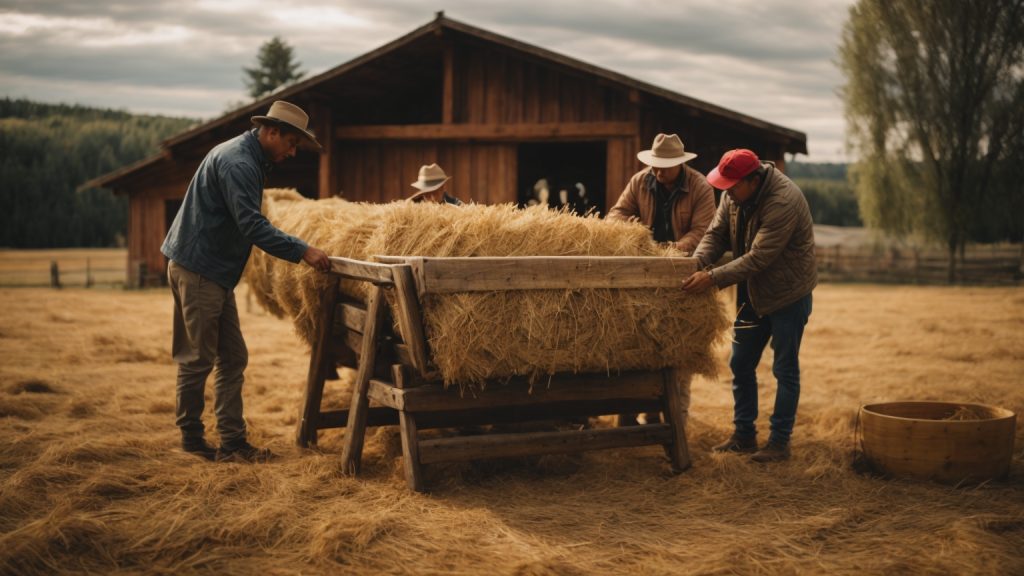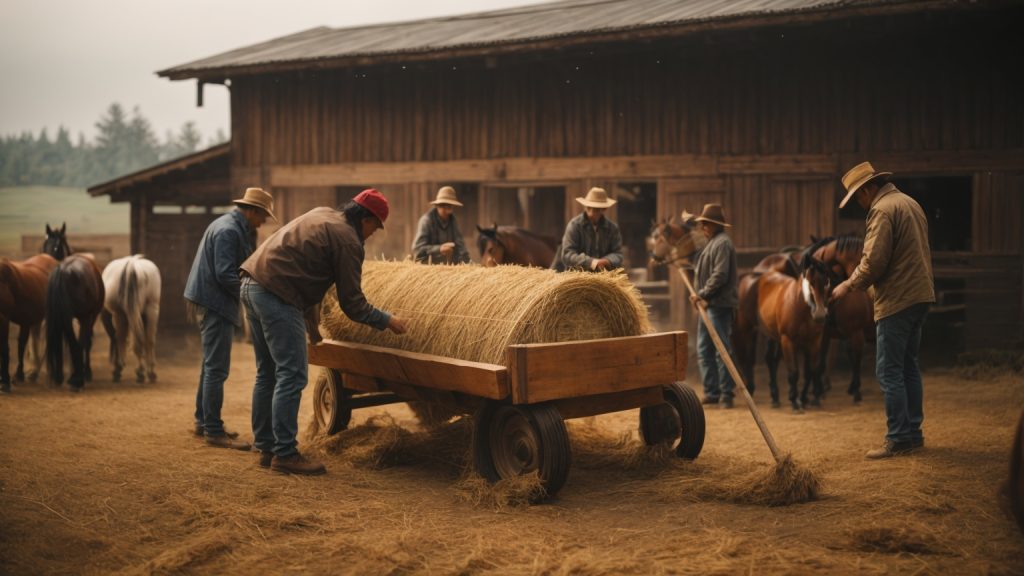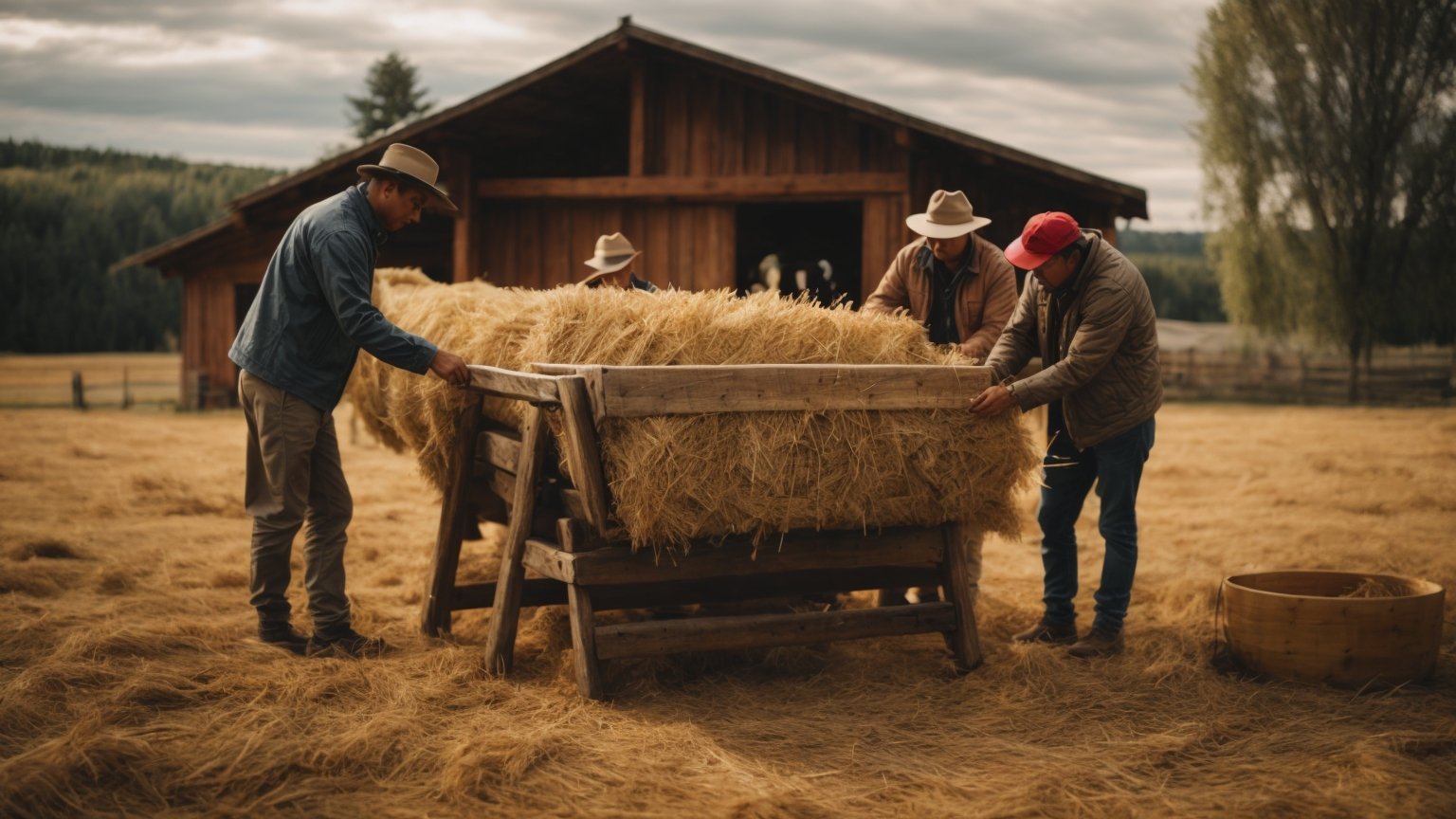If you’re a horse owner, you know how important it is to ensure that your horses are getting the right nutrition. One way to do this is by using a hay feeder. A hay feeder can help reduce the amount of hay wasted, promote better digestion, and even help prevent digestive issues like colic. However, buying a hay feeder can be expensive. Fortunately, making your own wooden hay feeder for horses is a relatively simple and cost-effective solution.
To make a wooden hay feeder for horses, you’ll need some basic woodworking skills and tools. The good news is that you don’t need to be an expert woodworker to build a hay feeder. With a little bit of patience and some guidance, you can create a sturdy and functional hay feeder for your horses. In this article, we’ll walk you through the steps of making your own wooden hay feeder for horses. We’ll cover everything from selecting the right materials to assembling the feeder. So whether you’re a seasoned woodworker or a beginner, you’ll be able to follow along and create a hay feeder that your horses will love.
Understanding Horse Feeding Habits

When it comes to feeding horses, it’s important to understand their natural feeding habits. Horses are grazers and are designed to eat small amounts of food throughout the day. In the wild, horses will spend up to 16 hours a day grazing on grasses and other vegetation.
When feeding horses, it’s important to mimic their natural feeding habits as much as possible. This means providing them with access to hay or grass throughout the day. However, it’s also important to control their intake to prevent overfeeding and potential health issues such as colic.
One way to control a horse’s hay intake is by using a wooden hay feeder. A hay feeder allows the horse to eat hay in a controlled manner, preventing them from consuming too much at once and reducing waste.
When building a wooden hay feeder for your horse, it’s important to consider the size of the feeder and the amount of hay your horse will consume. A feeder that is too small will not provide enough hay, while a feeder that is too large may encourage overeating.
Overall, understanding your horse’s natural feeding habits and providing them with a controlled feeding environment can help promote their health and well-being.
Materials Needed for a Wooden Hay Feeder
If you’re considering building a wooden hay feeder for your horses, you’ll need to gather some materials first. Here are the things you’ll need to get started:
Pressure-treated lumber
Pressure-treated lumber is a popular choice for building a wooden hay feeder because it’s resistant to rot, decay, and insect damage. When selecting pressure-treated lumber, make sure it’s marked as “ground contact” or “exterior use” to ensure it’s suitable for outdoor use.
Screws
You’ll need screws to hold the wooden pieces together. Make sure to use screws that are long enough to securely fasten the lumber together.
Saw
A saw is necessary to cut the pressure-treated lumber to the desired dimensions of your hay feeder. A circular saw or a miter saw are both good options for this task.
Measuring tape
Measuring tape is an essential tool for accurately measuring the lumber pieces. Make sure to measure twice to avoid any mistakes.
Drill
A drill is necessary for drilling pilot holes for the screws. This will prevent the wood from splitting when the screws are inserted.
Hardware cloth
Hardware cloth is a mesh material that can be used to cover the hay feeder to prevent the horses from wasting hay or injuring themselves on sharp edges. Make sure to use a heavy-duty hardware cloth to ensure it’s durable enough for outdoor use.
Paint or stain
Paint or stain can be used to protect the wooden hay feeder from the elements and to improve its appearance. Make sure to use a paint or stain that’s suitable for outdoor use and safe for horses.
By gathering these materials, you’ll be well on your way to building a sturdy and functional wooden hay feeder for your horses.
Choosing the Right Wood
When it comes to building a wooden hay feeder for your horses, choosing the right wood is crucial. You want to make sure that the wood you use is durable, safe, and resistant to weathering. Here are a few options to consider:
Pressure-Treated Lumber
Pressure-treated lumber is a popular choice for building horse hay feeders. The wood is treated with chemicals that protect it from rot, insects, and decay, making it a long-lasting option. However, it’s important to note that some horses may have allergies or sensitivities to the chemicals used in pressure-treated lumber. If you decide to use this type of wood, make sure to let it dry and air out for a few weeks before putting it in the pasture.
Cedar
Cedar is a naturally rot-resistant wood that is also resistant to insects. It has a pleasant aroma and is less likely to splinter than other types of wood. However, cedar can be more expensive than other options.
Oak
Oak is a strong and durable wood that is resistant to rot and insects. It’s a good option if you’re looking for a wood that will last a long time. However, oak can be more expensive and harder to work with than other types of wood.
Pine
Pine is a commonly used wood for horse hay feeders because it’s affordable and readily available. However, it’s important to choose a high-quality pine that is free from knots and defects. Pine is also more likely to rot and decay over time than other types of wood.
In conclusion, choosing the right wood for your horse hay feeder is important for the safety and longevity of the structure. Consider the pros and cons of each type of wood and choose the one that best fits your needs and budget.
Designing Your Hay Feeder

When it comes to designing your wooden hay feeder for horses, there are a few important considerations to keep in mind. This section will cover the key factors to consider when designing your hay feeder.
Size and Dimensions
The size and dimensions of your hay feeder will depend on a few factors, including the number of horses you have, their size, and their feeding habits. Here are some general guidelines to follow:
- A single horse should have access to at least 2 feet of linear feeder space.
- If you have multiple horses, you’ll need to provide enough feeder space for all of them to eat comfortably without competing for food.
- The height of the feeder should be such that the horse can easily reach the hay without having to stretch too far or bend down too low.
- The depth of the feeder should be deep enough to hold a sufficient amount of hay but not so deep that the horse has difficulty reaching the hay at the bottom.
Here is a table summarizing some recommended dimensions for your hay feeder:
| Number of Horses | Linear Feeder Space | Height | Depth |
|---|---|---|---|
| 1 | 2 feet | 4 feet | 2 feet |
| 2 | 4 feet | 4 feet | 3 feet |
| 3 | 6 feet | 4 feet | 4 feet |
Feeder Placement
The placement of your hay feeder is also an important consideration. Here are some guidelines to follow:
- The feeder should be placed in a well-ventilated area to prevent mold growth.
- The feeder should be placed away from high-traffic areas to prevent injury to the horses.
- The feeder should be placed in an area that is easy to access for filling and cleaning.
Here are a few additional tips to keep in mind:
- Consider placing multiple feeders in different areas of the pasture to prevent competition for food.
- If you have a particularly aggressive eater, consider using a feeder with a grate or mesh to slow down their eating and prevent choking.
By following these guidelines, you can design a hay feeder that meets the needs of your horses and helps ensure their health and safety.
Building the Frame
When building a wooden hay feeder for your horses, the frame is an essential component that provides stability and support. In this section, we will cover the steps involved in building the frame for your hay feeder.
Cutting the Wood
The first step in building the frame is to cut the wood to the appropriate size. You will need four pieces of wood for the frame, two long pieces, and two short pieces. The length of the long pieces will depend on the size of your hay feeder, while the short pieces should be the same width as the long pieces.
To ensure accuracy, it is essential to measure and mark the wood before cutting it. You can use a table saw or a circular saw to cut the wood to the correct size.
Assembling the Frame
Once you have cut the wood to the right size, the next step is to assemble the frame. Start by laying the two long pieces on a flat surface, parallel to each other, and then place the two short pieces between them, perpendicular to the long pieces.
To secure the frame, you can use wood screws or nails. Make sure to pre-drill the holes to avoid splitting the wood. You can use a clamp to hold the pieces together while you attach them.
After attaching the pieces, check to make sure the frame is square and level. You can use a carpenter’s square and a level to ensure accuracy.
With the frame assembled, you can now move on to the next step in building your wooden hay feeder for your horses.
Adding the Feeding Area
Once you have assembled the wooden structure of your hay feeder, it’s time to add the feeding area. This is where your horses will access the hay, so it’s important to ensure that it is secure and easy to use.
Creating the Hay Slots
The first step is to create the hay slots. These are the openings where your horses will access the hay. To create the hay slots, you will need to measure and mark the location of the slots on the feeding area. Once you have marked the location, use a jigsaw or circular saw to cut out the slots.
It’s important to make sure that the slots are large enough for your horses to access the hay, but not so large that they can easily pull out large amounts of hay at once. A good size for the slots is around 4-6 inches wide and 12-16 inches long.
Attaching the Feeding Area to the Frame
Once you have created the hay slots, it’s time to attach the feeding area to the frame of the hay feeder. To do this, you will need to use screws or bolts to secure the feeding area to the frame.
Make sure that the feeding area is level and securely attached to the frame. You don’t want it to wobble or come loose, as this could be dangerous for your horses.
Once you have attached the feeding area, you can add hay to the feeder and watch your horses enjoy their new feeding station. Remember to regularly check the hay feeder for any damage or wear and tear, and make any necessary repairs to ensure that it remains safe and functional for your horses.
Safety Measures
When building a wooden hay feeder for your horses, it is important to take safety measures to ensure that the feeder is secure and safe for your horses to use. Here are some safety measures to consider:
Sanding the Wood
Before assembling the wooden structure of your hay feeder, it is important to sand the wood to remove any rough edges or splinters that could harm your horses. Use sandpaper with a fine grit to sand down the edges of the wood pieces. Make sure to wear gloves and a dust mask to protect yourself from the dust and debris created by sanding.
Securing the Feeder
Once you have assembled the wooden structure of your hay feeder, it is important to secure it in place to prevent it from tipping over or collapsing. You can secure the feeder to the ground using stakes or anchors. Alternatively, you can attach the feeder to a wall or fence using brackets or screws.
It is also important to ensure that the feeder is stable and balanced. Make sure that the feeder is level and that the legs are evenly spaced. If the feeder wobbles or tips over, it could injure your horses or damage the feeder.
By taking these safety measures, you can ensure that your wooden hay feeder is safe and secure for your horses to use.
Maintenance Tips
To ensure that your wooden hay feeder lasts a long time and remains safe for your horses, it is important to perform routine maintenance checks and make any necessary repairs or replacements. Here are some tips to help you maintain your wooden hay feeder:
Routine Checks
Performing routine checks on your wooden hay feeder can help you identify any potential problems early on and prevent them from becoming bigger issues. Here are some things to check:
- Check for any signs of wear and tear, such as cracks, splinters, or loose screws.
- Inspect the feeder for any damage caused by weather or pests, such as water damage or termite infestation.
- Make sure the feeder is level and stable, and that it is securely anchored to the ground.
- Check the feeder periodically to make sure it is still in good condition and functioning properly.
Repair and Replacement
If you notice any damage or wear and tear on your wooden hay feeder, it is important to make any necessary repairs or replacements as soon as possible. Here are some tips to help you repair or replace your feeder:
- If you notice any cracks or splinters in the wood, sand them down and seal the wood with a waterproof sealant to prevent further damage.
- If any screws are loose or missing, replace them with new screws and make sure they are securely fastened.
- If any parts of the feeder are damaged beyond repair, replace them with new pieces of wood or hardware.
- If the feeder becomes unstable or unsafe, it may be necessary to replace it entirely.
By performing routine maintenance checks and making any necessary repairs or replacements, you can help ensure that your wooden hay feeder remains safe and functional for your horses.
